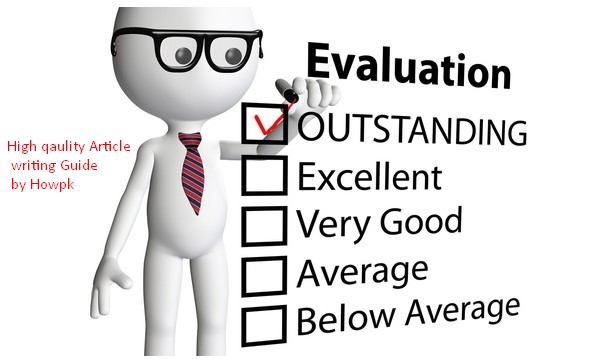Advertisements

As it always said by webmaster that “content is king”
you must need to concentrate on content while writing articles. So today I will be giving you 10 outlines to write quality article.
1) Researching for a topic:
We just cannot pick up a topic and write about it. In order to make your content worth appreciation, you need to have proper knowledge on the topic. This is where research comes in.
You can research your upcoming blog post by any of the following methods:
A) Wikipedia : Wikipedia is the first and foremost resource when you want to get the basic information as well as data statistics of a subject. But, sometimes this does not just fit all. Wikipedia can sometimes be biased or has information that can be manipulated. In that case, you can include the following tools for research:
B) Google scholar: Google scholar is my go-to source when it writing on topics that need references from university articles, thesis by experts and other published research papers.
C) Google books: Citing quotes and references from books under public domain can be a great add for your blog post. You can customize Google books to source such information for your upcoming blog posts.
Project Gutenberg is the largest collection of free books that you can edit, twist and use for your commercial blog posts.
Other such places, where you can find hidden knowledge to make your post outstanding are The Internet Archive which has way too much information that sometimes can be a gold mine, Google Public data also has some wonderful resources based on your niche.
2) Writing headlines:
People have an average attention span of just 8 seconds and no matter how intriguing your blog post is, no one will read it if they are not convinced that it is worth their time within the first few seconds.
So, you have to make your headlines or titles so smart that they just cast a spell on your readers. A boring headline can drive them out even if the content inside is rich in information.
Similarly, a headline that doesn’t deliver its promise will irk your reader and he will never trust your site again. That’s how important headlines are! Here is an ultimate resource of headlines that work on any content type.
Bonus: Use a free title generator like
Portent’s title maker to write breathtaking headlines that will cast a spell on your readers. Try it.
3) Writing the researched data into a well-formatted post:
While all the researched data are valuable, it isn’t actually needed as it is. They will scare your readers away and moreover raw data is useless unless it is meaningfully processed. So follow these tips to get your writing to the next level.
a) Start with a fact, an intriguing question or a positive hope:
Kindling the hope of something good in the reader’s mind can keep him stuck to your post till the end. Facts will help you catch the attention of the reader. While a good hope kindling opening paragraph like the below might get all the positive attention of the reader.
“So, how much did your fruit orchard yield this summer? What if I told you can earn threefold with that much fertilizer and half the labor done? Recent developments in machinery farming equipment have really made farming a single man’s quest.”
As you will notice I started by giving them the hope of earning 3X which is very positive and the reader will surely read further to know how.
b) Do not limit yourself to one-dimensional reader:
In that above paragraph, I started by asking a question to my readers (agriculture or big orchard owners) on the earnings on their farm this year. I never said or gave them a finite number. If I would have said, “I hope you earned above 50$” it would have been a finite question whereas many who earned more or less than that would not read my post further.
Secondly, I did not lure them saying you can make 500$ (again a finite number) more from your farm. I said they can earn three times more which indicates it can be 150$ for someone who earned 50$ and 3000$ for someone who earned 1000$ from their orchards.
This is how I made my content appeal everyone.
4) Use long tail keywords:
Keywords are still important if you want some traffic from search engines. However, having keywords less than three to four words makes it quite broad to appeal to a single reader base.
For example, if you (an Australian) weave your content around the keyword “ car mechanic shop” you are sure to compete with millions if not billions of other car mechanic shops in the whole world.
Another thing is even if you rank for car mechanics your readers will not be convertible because you simply are not situated near to the location.
Like if an American car owner dropped to your site from a search engine he would simply bounce off seeing your local business address situated in Australia.
Again, if you consider using a long tail keyword like “car repair shop in south Sydney” You have to compete with ten times less other sites and you have targeted visitors who could be easily converted into your leads or clients.
This is what is called long tail keywords. I use Long Tail Pro to find highly converting keywords that are easy to rank.
Long tail keywords are something that can make your post more unique because many people won’t choose them due to fewer searches. I, however, suggest you to use them to bring in more committed traffic. See how you can find highly profitable keywords by doing keyword difficulty analysis.
5) Use LSI Keywords for even more optimized post:
The most optimized blog post is the one not optimized at all (written naturally)
The most optimized blog post is the one not optimized at all. Click to Tweet
But many of us always tend to stuff keywords and meta tags to the post that turns it spammy in the eyes of Google.
Google’s hummingbird algorithm now checks for how a page is related to a concept rather than just a term or phrase. It targets conversational search queries. While this is good news for those focusing on writing on detailed articles, it definitely robs the keyword stuffed sites circling around just one or two phrases.
The ultimate aim of using latent semantic indexing for ranking pages on Google is to empower pages that focus on providing value to the readers.
For example, if you had a post on “dog keeping” you got to mention terms like “dog food”, “optimum temperature for dogs” and terms like “dog brush”, “soap for dogs” etc.
How to use LSI Keywords to get your pages the ranking they deserve:
1. Use a variety of anchor texts for internal linking.
2. Search for Google to find related terms.
3. You can also use Google’s auto-predict feature to see what terms are being thrown for your phrase.
4. Use a lexical database to get more synonyms and in-depth related terms and phrases.
5. You can also use AdSense sandbox feature to see what ads are being displayed when a page is loaded so that you could use those terms in your post. Reason behind this is ad copies are often the most researched word groups.
Read this detailed guide to LSI Keywords!
6) Internal linking:
Internal linking a post not only adds value to the articles linked in the post but also makes your content more relatable by adding related articles that the reader can refer while reading the article. You should at least add three (it’s not fixed and depends on the length of the post used) internal links to each of your posts.
Also, edit the old posts and include links to recent articles in them as internal links as it will help in faster indexing of new articles and also pass some SEO juice to them.
Why should we do effective internal linking?
Read this guide to learn effective internal linking techniques (with examples and imp. tools).
7) On-page SEO:
While a quality blog post should be devoted to the readers, it should also please the search spiders to rank them for those readers.
On page SEO is also very important to let the search engine bots know what your content is all about. A quality article which is expected to be loved by search engines are ought to be SEO optimized. You should not hesitate to link to authority sites (the relevant ones) in fear of bleeding SEO juice. Linking to other authority blogs can make your content more relevant and trustworthy.
On-Page SEO includes internal linking (explained above), adding of related keywords, optimizing images for search engines etc. Don’t forget to check these 5 Lesser Known On-Page SEO Optimization Techniques.
8) Scan ability:
Books are easier to understand or preview because they have an index page. This makes the reader scan the contents of the page.
Similarly your content should be scan-able. You need to provide a complete road map for the readers who don’t have time to go in-depth reading all your paragraphs.
Here is where subheadings and bulleted points come into play. You can use subheadings to tell your reader what the whole content is about. A subheading should be distinct and should have the power to predict the paragraph underneath.
If you write super long in-depth posts this
guide will help you tame the length.
9) Call to action:
A post without a clear call to action is like car without a steering.
You need to be sure as to what you intend your audience to do after reading a post.
If it is a review post, your audience should go check the product after reading the review.
If you have a motivation post, you would want the reader to take a positive action.
If it is your about page, you would want your reader to have trust for you (after reading the page). My post (the current one) intends to you to go and take steps to writing a better blog post.
It is up to you, how you use CTA into your post. You can use it to get more comments, social shares and more email subscribers too. I highly recommend you to read this CTA guide to learn more.
10) Write like an authority:
Last but not the least, you should write as if you are an authority in the subject.
Yes, you have to appear even if you are not yet an authority.
No one will like a site that is written (or appears to be) like a newbie.
Your sentence structure and grammar should be compelling. Write short and crisp paragraphs. Double check your grammar, you always need to proofread because you never know when a typo might surface. I use Grammarly for proofreading and checking my grammar and spelling errors .
You should also check if something you wrote matches with something written prior to you.
I know you don’t plagiarize; but not your audience. So it is better to check and remove any traces of copied sentences (or even styles of writing) before you are caught.
Use a tool like Grammarly to check your content for traces of plagiarism.
Final words:
Quality content can be anything. (check these 9 types of content)
You don’t need to be a scientist to write great researched posts. Your aim should be to provide value to the readers.
Additionally, you must take care that your content is presented safely to the search bots. There is no point over-optimizing the content.
